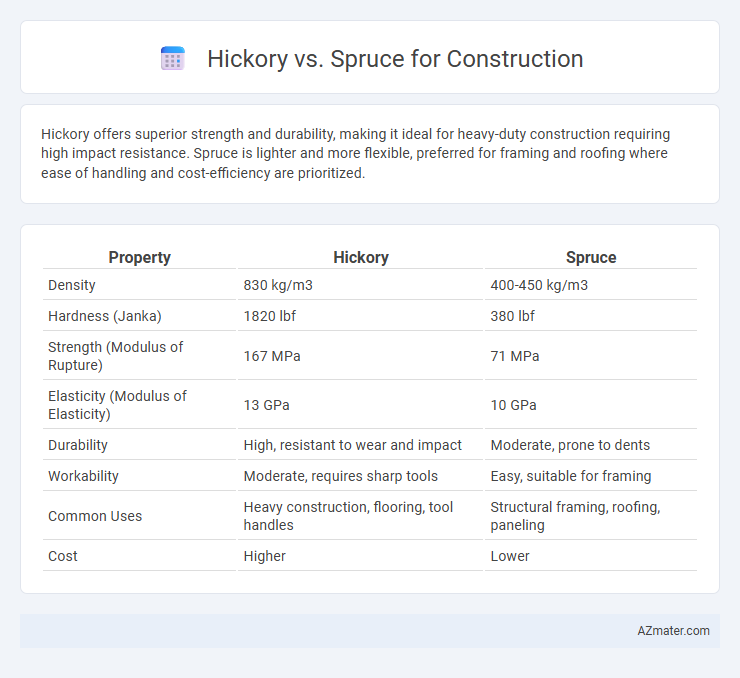Hickory offers superior strength and durability, making it ideal for heavy-duty construction requiring high impact resistance. Spruce is lighter and more flexible, preferred for framing and roofing where ease of handling and cost-efficiency are prioritized.
Table of Comparison
| Property | Hickory | Spruce |
|---|---|---|
| Density | 830 kg/m3 | 400-450 kg/m3 |
| Hardness (Janka) | 1820 lbf | 380 lbf |
| Strength (Modulus of Rupture) | 167 MPa | 71 MPa |
| Elasticity (Modulus of Elasticity) | 13 GPa | 10 GPa |
| Durability | High, resistant to wear and impact | Moderate, prone to dents |
| Workability | Moderate, requires sharp tools | Easy, suitable for framing |
| Common Uses | Heavy construction, flooring, tool handles | Structural framing, roofing, paneling |
| Cost | Higher | Lower |
Introduction to Hickory and Spruce in Construction
Hickory is valued in construction for its exceptional hardness, strength, and shock resistance, making it ideal for structural components and tool handles that require durability. Spruce, commonly used in framing and roofing, offers a high strength-to-weight ratio and excellent workability, which contributes to its popularity in residential and commercial building projects. Both woods possess unique characteristics that influence their suitability, with hickory excelling in impact-resistance applications and spruce providing lightweight support with ease of machining.
Wood Characteristics: Hickory vs Spruce
Hickory wood exhibits exceptional hardness and density, making it highly resistant to impact and wear, suitable for heavy-duty construction tasks requiring durability. Spruce is lighter and less dense, offering excellent strength-to-weight ratio and flexibility, often preferred for framing and structural applications where ease of handling is crucial. Both woods have distinct grain patterns; hickory's coarse and irregular grain enhances toughness, while spruce's straight grain promotes stability and uniform shrinkage.
Strength and Durability Comparison
Hickory wood exhibits exceptional strength with a Janka hardness rating of 1,820 psi, making it one of the toughest domestic hardwoods ideal for heavy construction and flooring. Spruce, with a lower Janka hardness around 510 psi, is softer but offers excellent strength-to-weight ratio, commonly used in framing and structural applications where lightweight and stability are essential. Durability-wise, hickory's dense grain structure provides superior resistance to wear and impact, while spruce tends to be more prone to dents and moisture-related damage without proper treatment.
Workability and Installation Differences
Hickory is dense and hard, offering exceptional strength but requiring advanced tools and effort for cutting and fastening, which may impact installation speed. Spruce, being lighter and softer, provides easier workability, allowing quicker cutting, nailing, and shaping, making it more suitable for faster construction projects. The difference in hardness and grain structure between hickory and spruce directly affects labor intensity and installation efficiency in construction applications.
Moisture Resistance and Stability
Hickory offers superior moisture resistance compared to spruce, making it less prone to swelling and warping in humid environments. Spruce, while lighter and easier to work with, tends to absorb more moisture, leading to reduced dimensional stability over time. For construction projects requiring durability in variable moisture conditions, hickory provides greater long-term stability and resistance.
Cost Analysis: Hickory vs Spruce
Hickory, known for its density and durability, typically costs more per board foot than spruce, which is lighter and more affordable. Spruce offers a cost-effective option for large-scale construction projects due to its lower price and ease of handling during installation. When evaluating total expenses, consider that hickory's superior hardness may reduce maintenance and replacement costs over time despite the higher upfront investment.
Applications: Best Uses for Each Wood
Hickory's exceptional hardness and shock resistance make it ideal for heavy-duty construction applications such as flooring, tool handles, and furniture that require durability and impact resistance. Spruce's lightweight and good strength-to-weight ratio make it suitable for structural components like framing, trusses, and roof decking where ease of handling and stability are key. Choosing between hickory and spruce depends on whether toughness or lightweight structural support is the primary requirement.
Sustainability and Environmental Impact
Hickory offers exceptional durability and strength, which contributes to its long lifespan and reduces the need for frequent replacement, thereby lowering environmental impact over time. Spruce, being lighter and faster-growing, has a smaller carbon footprint due to quicker renewability and efficient harvesting practices. Both woods can be sustainably sourced, but Spruce's rapid growth cycle makes it more favorable for eco-friendly construction projects focused on reducing deforestation and promoting carbon sequestration.
Maintenance and Longevity
Hickory, known for its exceptional hardness and density, offers superior resistance to wear and physical damage, reducing maintenance frequency in construction applications. Spruce, while lighter and easier to work with, is more prone to dents and scratches, requiring regular sealing and protection to prevent moisture damage and decay. Hickory's natural durability provides longer structural integrity, often exceeding the lifespan of spruce in high-stress or outdoor environments.
Choosing the Right Wood for Your Project
Hickory offers exceptional strength, hardness, and shock resistance, making it ideal for heavy-duty construction projects and flooring that requires durability. Spruce provides a lightweight, flexible option with good tensile strength, commonly used for framing, roofing, and soundboards in musical instruments due to its acoustic properties. Selecting hickory ensures long-lasting structural support in high-stress applications, while spruce is preferred for projects needing easy handling and cost-effective materials without compromising stability.

Infographic: Hickory vs Spruce for Construction
 azmater.com
azmater.com